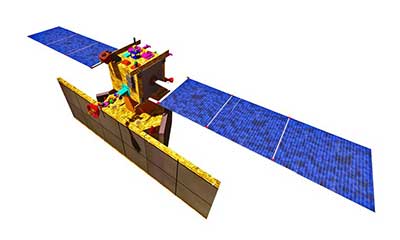Relevance: GS-3 : Science and Technology- developments and their applications and effects in everyday life; Achievements of Indians in science & technology; indigenization of technology and developing new technology; Awareness in the fields of Space.
Key Phrases : ISRO, Earth Observation Satellite, EOS - 04, INS-2TD, technology demonstrator, INSPIREsat-1, student satellite, PSLV-C52, reliable workhorse, Bhutansat-India-Bhutan joint satellite, radar imaging satellite, RISAT, INSPIRE
Why in News?
- ISRO’s first launch of 2022 and under the new Chairman S. Somanath went off without a glitch, placing all the three satellites into their intended orbit with precision.
Highlights:
- ISRO successfully launched its Earth Observation Satellite, EOS - 04, the INS-2TD, a technology demonstrator from ISRO and the INSPIREsat-1, a student satellite, from the launch pad at the country’s only spaceport in Sriharikota, Andhra Pradesh.
- The PSLV C-52 was the 54th flight of the PSLV (dubbed the 'reliable workhorse' of the ISRO) and the 23rd mission using the PSLV-XL configuration.

Earth Observation Satellites:
Two years ago, ISRO had moved to a new naming system for its earth observation satellites which till then had been named thematically, according to the purpose they were meant for.
- The Cartosat series of satellites were meant to provide data
for land topography and mapping, while the Oceansat satellites were
meant for observations over sea. Some INSAT-series, Resourcesat
series, GISAT, Scatsat, and a few other earth observation
satellites were named differently for the specific jobs they were
assigned to do, or the different instruments that they.
- All these would now become part of the new EOS series of satellites.
- However, only the first of these newly named satellites, EOS-01,
launched in November 2020, is in orbit right now.
- EOS-02, a micro-satellite to be flown on a new launch vehicle called SSLV (Small Satellite Launch Vehicle) is yet to be launched,
- The launch of EOS-03 had ended in a failure (GSLV F10) in August, 2021.
Significance:
- The success of the launch was crucial for ISRO that had a very muted
2021 with just two launches, one of which - the GSLV- F10 failed after
launch.
- The PSLV-C52/EOS-04 mission too has been delayed twice already due to the coronavirus pandemic.
- ISRO has attempted only four missions, of which one failed, through 2020 and 2021.
- India’s first solar mission Aditya-L1, the third lunar mission with just the lander and rover Chandrayaan-3, and the first uncrewed flight under the Gaganyaan mission were all supposed to happen in 2020 but were pushed back initially to 2021 and then further after the second wave of the pandemic.
- With a mission life of 10 years, the EOS-4, a radar imaging satellite
is designed to provide high quality images in all weather conditions for
applications such as agriculture, forestry, plantation, flood mapping, soil
moisture and hydrology.
- It would replace the RISAT-1 which was launched in 2012 but has been non-functional for the last few years. RISATs use synthetic aperture radars to produce high-resolution images of the land.
- One big advantage that radar imaging has over optical instruments is that it is unaffected by weather, cloud or fog, or the lack of sunlight. It can produce high-quality images in all conditions and at all times, making it suitable for surveillance.
- The satellite will collect earth observation data in C-band and will complement and supplement the data from Resourcesat, Cartosat series and RISAT-2B series.
- The INS-2TD is a precursor to the India-Bhutan joint satellite [INS
2-B] and will assess land and water surface temperatures, delineation of
crops and forest and thermal inertia.
- It has a thermal imaging camera and can help in the assessment of land surface temperature, water surface temperature of wetland or lakes, delineation of vegetation (crops and forest) and thermal inertia (day and night).
- The two countries had signed a space agreement last year, and its first outcome would be the launch of BhutanSat, or INS-2B, on a PSLV rocket in March.
- The INSPIREsat-1(a cubesat) is a student satellite from the
Indian Institute of Space Science and Technology in association with the
University of Colorado, USA and is aimed at improving the understanding of
ionosphere dynamics and the Sun’s coronal heating processes.
- To be placed in a low earth orbit, INSPIRESat-1 has a mission life of one year.
- It is in reality, the third satellite in the constellation to be launched, but it will be the first by the ISRO.
- INSPIRESat-2 and 5 were launched by SpaceX.
-
INSPIRE: Short for the INternational Space Program in Research and Education which kicked off in 2017 - envisions a constellation of earth and space weather observation satellites.
- The INSPIRE programme has been a rewarding experience for both the students and faculty of the IIST.
- Not only has it given the students insights into spacecraft design and development, but it has also equipped them for handling collaborative projects.
Way Forward:
- As many as 19 launches are planned this year, including a few big-ticket ones like the Chandrayaan-3 and the uncrewed Gaganyaan mission. This makes 2022 the busiest calendar for ISRO since its inception.
Trivia:
- As per the government’s reply in parliament, India currently has 53 operational satellites, of which 21 are earth observation ones and another 21 are communication-based. Eight are navigation satellites, while the remaining three are science satellites.
Source: The Hindu , Indian Express
Mains Question:
Q. Discuss the opportunities and challenges in the Indian Space sector and the role of ISRO in it. (250 Words)









